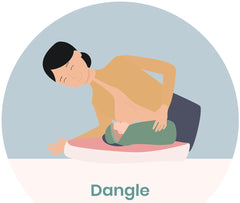There's no definitive right or wrong way to hold and feed your baby; each mom and baby will discover their preferred position for breastfeeding. The key is ensuring both you and your baby feel comfortable during the feeding process. As life demands versatility, especially as your baby grows, and you venture out more, it's beneficial to be acquainted with various breastfeeding positions and techniques.
Explore 11 different breastfeeding positions to find what suits you and your baby best:
- Laid Back Breastfeeding or Relaxed Position
- Classic Cradle Hold
- Cross-Cradle Hold
- Football Hold
- Side-Lying Position
- Laid-Back Breastfeeding After a C-Section
- Upright Breastfeeding or Koala Hold
- Dangle Feeding
- Nursing In A Sling
- Double Football Hold
- Dancer Hand Nursing Position
Regardless of the chosen position, keep in mind the following tips:
- Gather necessities before starting the feeding session, such as a drink, snacks, mobile phone, TV remote, book, or magazine.
- Ensure your baby is comfortable and well-supported, avoiding any twisting of their head, neck, or spine.
- Prioritize your own comfort by using cushions, pillows, or rolled towels for back or arm support.
- Check that your baby latches on correctly, as a proper latch is crucial for comfortable breastfeeding.
Laid Back Breastfeeding or Relaxed Position
When it comes to feeding your little one, there's no strict rulebook – each mom and baby will find their groove with a preferred position. The laid-back breastfeeding technique, also known as biological nurturing, is often a go-to for many moms. If your baby is placed on your chest or tummy right after birth, they might naturally do the 'breast crawl' towards one of your breasts, trying to latch on. This skin-to-skin contact stimulates feeding instincts, and gravity lends a hand in ensuring a secure latch.

This approach isn't exclusive to newborns; it can be a lifesaver with babies of any age. It's particularly handy if your baby faces challenges latching in other positions, isn't a fan of head touches while feeding, or if you're dealing with a forceful letdown. A mom friend shared, "My combination of generous curves and a petite 6-pound baby made positioning tricky initially. It took me a few weeks to understand there's no 'should' when it comes to positions. Ultimately, I embraced breastfeeding lying down with my baby comfortably nestled on top of me."
For added comfort, a gentle recline beats lying flat on your back. Use cushions or pillows to ensure you and your baby are fully supported during these precious moments.
Embracing the Classic Cradle Hold
When envisioning breastfeeding, the classic cradle hold often comes to mind. Picture yourself sitting upright with your baby nestled on their side, head and neck resting along your forearm, and their body snug against your stomach in a tummy-to-tummy pose. While widely popular, this position might pose a challenge with a newborn as it doesn't offer as much support.

Enhance your comfort with a pillow or cushion behind you and a breastfeeding pillow across your lap for extra support. Be cautious not to elevate your baby too high with the pillow, maintaining a natural resting height for your breasts to avoid discomfort and strained latching. Another mom shares she found solace in the cradle hold, expressing, "It worked like a charm! I felt comfortable, just sitting there and admiring my baby."
Switching it up with the Cross-Cradle Hold
Similar to the cradle hold, the cross-cradle hold switches the roles of your arms. Your baby's body lies along your opposite forearm, offering excellent support around the neck and shoulders. This position aids newborns and those with latching difficulties.

In the early days, avoid supporting your baby around their head to prevent a shallow latch and sore nipples. As your baby grows, you'll find this technique becomes more manageable, allowing you to rest your baby's head in your hand.
Football Hold - Keeping It Close
The football hold, also known as the underarm or clutch, involves sitting with your baby resting along your side. This position provides excellent support for your baby while offering you control and a clear view of their face. Amy, a mom of two, recalls her experience, "With my first daughter, my ample K-size breasts, double the size of her head, posed a challenge. I used a rugby ball hold, slightly upright to avoid overwhelming her with their size. It worked well, especially with my c-section wound."

This position is beneficial for moms who've had a c-section, twins, or a premature baby, as well as those with larger breasts. Ensure your baby feels secure by keeping them tucked in close.
Getting Cozy with the Side-Lying Position
Perfect for those relaxed night feeds or breastfeeding sessions in bed or on the sofa, the side-lying position offers comfort, especially if you've had a caesarean or stitches.

For this mom the side-lying position became a necessity due to her baby's tongue-tie. "She just couldn't latch any other way. As she grew, she became much better at attaching in the regular way," she explains.
Relaxing with Laid-Back Breastfeeding After a C-section

If you've had a caesarean delivery and are searching for a comfortable breastfeeding position, consider the laid-back approach. Reclining with your baby's body across your shoulder provides a nursing option without putting pressure on your wound. Alternatively, you can explore the side-lying position for added comfort.
Upright Breastfeeding or Koala Hold – A Vertical Embrace
In the upright or koala hold, your little one perches, straddling your thigh or resting on your hip, with their spine and head held high as they indulge in their feeding session. This hold is versatile; it caters to newborns with ample support or becomes a practical choice for older babies who can sit unassisted. The koala hold shines as the go-to breastfeeding position for babies dealing with reflux, ear infections, or those with a tongue-tie or low muscle tone, as it provides a comfortable upright stance

Peggy, a mom from Switzerland, attests to the benefits of the upright hold, especially as her baby grew older. She shares, "As my baby matured, the upright hold became our preferred choice. It offered comfort for both of us, and I could still feel her tiny body close to mine. Plus, it was discreet for public feeds."
Dangle Feeding – A Gravity-Assisted Approach

Ellie, a mom of two from the UK, recounts her experience with dangle feeding during blocked ducts, saying, "It seemed to help – I think because gravity was on my side, and the different angle and position encouraged my baby to drain my breast differently from our usual feeds."
Although not an everyday choice, the dangle feeding position might just be the mix-up you need, as Lorna from the UK found when struggling with her baby's latch. "It wasn't the coziest way to breastfeed, but at that time, I'd do anything to get him to latch. It worked – and we're still breastfeeding eight months on!"
Nursing in a Sling – On-the-Go Comfort
Mastering the art of breastfeeding in a sling takes a bit of practice, but it proves to be a convenient option when you're out and about, multitasking with older children, or tackling light chores. Lindsay, a mom of two from the US, shares her experience, "I often used a front carrier with both my babies. When we were out, I tied a Toci Nursing Cover around my neck and draped it over the carrier. They would nurse like this until they peacefully dozed off.

This method is most effective when your baby is an experienced breastfeeder and can independently support their head. Whether it's a stretchy wrap, ring sling, or front carrier, ensure you always have a clear view of your baby's face, with their chin comfortably away from their chest.
Double Football Hold – Tandem Feeding Simplified
For moms of twins, there are other positions to explore, like two cradles crossed, one twin in a football hold and one in a cradle hold, and double laid-back or double upright breastfeeding positions.
 Emma, a mom of two from the UK, found tandem feeding essential when her twins arrived. "With my twins needing feeding every two hours, day and night, I had to tandem feed. The double rugby ball (or football) hold, paired with a breastfeeding cushion, was my go-to," she explains.
Emma, a mom of two from the UK, found tandem feeding essential when her twins arrived. "With my twins needing feeding every two hours, day and night, I had to tandem feed. The double rugby ball (or football) hold, paired with a breastfeeding cushion, was my go-to," she explains.Dancer Hand Nursing Position – Tailored Support for Special Cases
In situations where your baby struggles to maintain a latch or has low muscle tone, the dancer hand nursing position provides customized support for both their head and your breast. Begin by cradling your breast, with your hand underneath, fingers on one side, and thumb on the other. Gradually edge your hand forward, creating a 'U' shape with your thumb and index finger just in front of the breast. The remaining three fingers continue supporting the breast underneath.
 Your baby's jaw rests on your thumb and index finger, with their chin nestled at the bottom of the 'U.' This hold ensures ample support and allows you to control their position while maintaining a clear
Your baby's jaw rests on your thumb and index finger, with their chin nestled at the bottom of the 'U.' This hold ensures ample support and allows you to control their position while maintaining a clear
Feel free to share your experiences or seek support from lactation consultants or breastfeeding specialists if needed. Remember that the goal is for both you and your baby to have a positive and comfortable breastfeeding experience.








